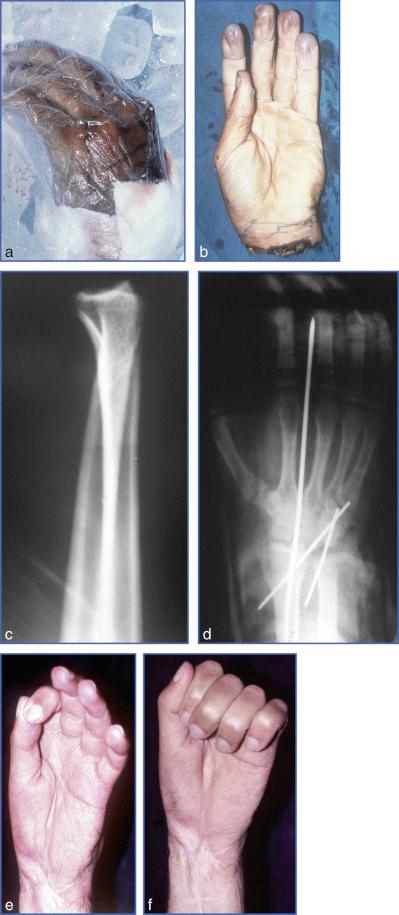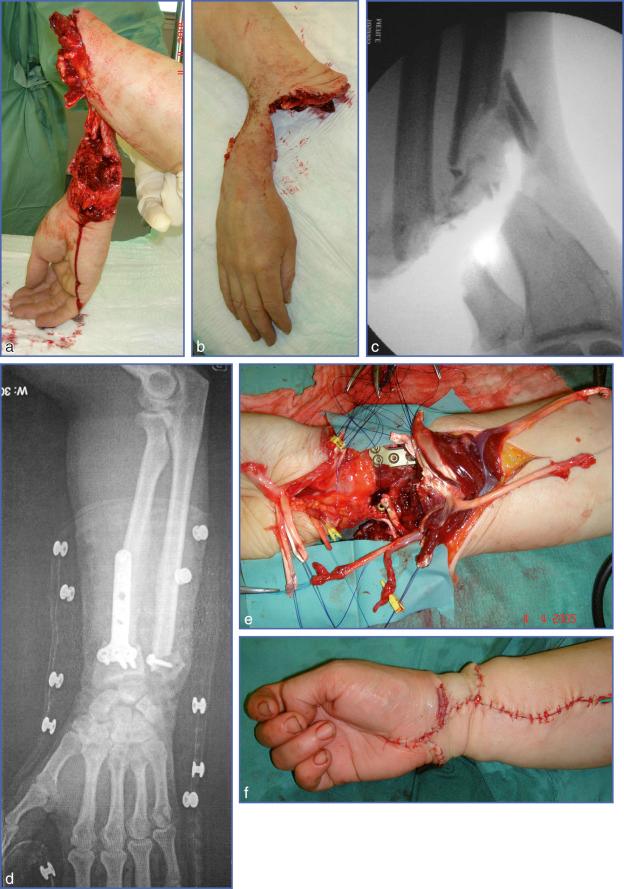Physical Address
304 North Cardinal St.
Dorchester Center, MA 02124
Although the replantation of a hand is certainly spectacular, it may seem less demanding technically than a digital replantation. There are, however, many problems that remain to be solved, given the possibility of muscle ischemia, technical choices related to osteosynthesis of the radiocarpal and carpometacarpal skeleton, revascularization requirements, nerve repair and, finally, the treatment of soft tissue defects that accompany this type of trauma.
Since the first arm replantation performed by Malt in Boston in 1962, it has become apparent that the quality of functional recovery is directly related to the quality of nerve regeneration. It is conventional to define the level of amputation based on radiologic criteria that specify the location of the fracture. Our experience is different and shows that replantation criteria should be based primarily on the level of nerve injury and not on that of the bone fractured.
The problem is not only ensuring survival of the limb but also its functional outcome. It is fairly standard to observe a disarticulation of the hand in the wrist with a nerve avulsion in the forearm, as a disarticulation of the shoulder with avulsion at the level of the brachial plexus.
The primordial importance of nerve recovery calls for a primary nerve repair technique without tension, even at the cost of shortening the skeleton.
Our experience also confirms the experience of other teams regarding the functional outcome according to the level of amputation. Proximal amputations—in other words between the lower third of the forearm and the carpometacarpal joint—have a functional outcome that is better than distal transmetacarpal amputations. At this level it is difficult to hope for recovery of the intrinsic muscles, and tendon and neurovascular repair is technically more difficult.
The initial assessment must specify the mechanism of injury: clean-cut amputation, crushing or avulsion mechanisms, singly or in combination. Machine withdrawal maneuvers may be added to these mechanisms, which cause additional elongation injuries.
Clean amputations are rare, and injury levels vary depending on the elastic resistance of the tissues, which is not the same for the arteries, veins and nerves.
The replantation strategy is linked to the injury mechanisms. It is different for a clean amputation, an amputation by crushing or by avulsion, and different injury mechanisms can be combined.
The patient's general condition must be thoroughly evaluated to confirm an indication for replantation.
The clinical history will clarify whether this is a single trauma, because it is hardly possible to carry out a replantation for several hours if the injured person has also sustained a head, chest, abdominal injury and so on. Blood loss should be known because a hand replantation at the moment of releasing the tourniquet may generate significant blood loss. Age, diabetes and smoking are factors directly influencing the success rate and quality of functional outcome.
Furthermore, it is important to determine the actual functional contribution the replanted hand will bring to a manual worker with high functional demands. Whereas a clean amputation will give a higher functional outcome compared with the best prosthetics, this is not the case for an avulsed hand, where the nerves can only be repaired by grafting.
In women, for aesthetic reasons, there are fewer contraindications for replantation than in the manual worker, where it is important to explain the limitations of this surgery and the disability that may represent an insensitive and nonfunctional hand.
With microsurgery it is almost always possible to replant a hand, but sometimes it is a mistake to be extreme about it. It is only through the experience of the surgeon that we acquire rigor in the indications.
We have reviewed the conditions for preservation of amputated fingers in Chapter 15 . Any error causes complications, even contraindications to replantation, and only repeated education can prevent this.
Recall that the amputated limb should be surrounded by a dressing and then enclosed in a sealed plastic bag and placed on ice to protect the tissues against anoxia by bringing them to 4°C ( Fig. 16.1a ).

For the stump, it is usually not necessary to set up a tourniquet, which could potentially create a second level of injury. A simple compression bandage is enough to ensure hemostasis of the radial, ulnar and possibly interosseous arteries.
This chapter is devoted exclusively to complete amputations of the hand. It is important to differentiate between amputation and devascularization. In the latter case there is a continuity of certain tissue components (skin, tendon, etc.) that will change the prognosis, although the hand is completely devascularized. Indeed, these tissues in continuity often ensure venous and lymphatic return. It is therefore essential during débridement to preserve these tissue bridges.
Revascularization techniques have been elaborated in Chapter 8 . Our purpose here is to present the technique of replantation of a completely severed limb ( Fig. 16.2 ).

Circulatory arrest in the amputated hand has important but variable consequences depending on the tissues involved.
The anoxia associated with catabolites can lead to permanent tissue damage. This explains the importance of limiting these effects by carrying out perfect hypothermic preservation and quickly revascularizing the tissues (see Chapter 2 ).
The skin and subcutaneous tissue are particularly tolerant to ischemia insofar as refrigeration at 4°C is carried out. We were therefore able to successfully replant the scalp of a 4-year-old who had to travel more than 1000 km to reach our service.
Anderl also reported a case of free groin flap transfer which had been preserved with a cold ischemia time of 30 hours.
Bone ischemia is quite well tolerated in adults for the first 4–5 days according to Albrektsson. However, it seems that after 12 hours of ischemia, there will be a delay in callus formation. In children, tolerance to ischemia is lower because the growth cartilages are altered at the end of the second hour.
The wall of the lymphatic vessel deteriorates from the eighth hour onward. After replantation, reorganization begins on the fourth postoperative day, to be functional between the 8th and 14th days.
Ischemia of the peripheral nervous system leads to numerous metabolic disturbances from the eighth hour onward, in particular in the blood-neural barrier, axonal conduction and the motor end plate. The edema that sets in brings about a true compartment syndrome. After revascularization, to avoid the harmful effects of edema, it is fundamental to perform a fasciotomy of all the compartments of the forearm and intermetacarpal spaces and to free the median nerve in the carpal tunnel and the ulnar nerve in Guyon's canal. However, it is not necessary to carry out an intraneural neurolysis, which may impair the vascularization of the nerves.
Muscle is also very sensitive to ischemia. It is necessary to ensure a blood flow of 1.35–6 mL/min per 100 g of muscle to maintain its metabolic activity. Ischemia creates anaerobic conditions conducive to metabolic acidosis and then superinfection. The accumulation of catabolites in the muscle mass must be taken into account at the time arterial circulation is restored. To avoid returning these catabolites into the general circulation, which creates significant disorders of peripheral vascular permeability, it is prudent not to perform reanastomosis of the venous system until the replanted hand has been “washed” with arterial blood, flushing out the catabolites.
It is remarkable to observe the venous return for the first minute of recirculation, which is burgundy in color. During this period, vasodilation is established, causing significant blood loss that needs to be noted by the team of anesthetists. If there has been a long period of ischemia of the muscle mass at the stump, it is prudent to carry out an excision to prevent necrosis and secondary infection. In the hand, fasciotomy of all the interosseous muscles is essential to limit the effects of edema, which sets in after revascularization.
Become a Clinical Tree membership for Full access and enjoy Unlimited articles
If you are a member. Log in here